The Work Continues—Tzu Chi’s Quake Relief in Myanmar
By Chiu Chuan Peinn and Li Wei-huang
Translated by Wu Hsiao-ting (吳曉婷)
The Work Continues—Tzu Chi’s Quake Relief in Myanmar
By Chiu Chuan Peinn and Li Wei-huang
Translated by Wu Hsiao-ting (吳曉婷)

On April 11, volunteers delivered bread, milk, and rice to Pyi Lone Chan Thar Ethnic Orphanage, which was founded by a monastery and shelters 180 children. A monk is seen here guiding the volunteers as they assess the earthquake damage. (Khin Yadanar Thein)
"The hotel windows rattled, and we could hear a low rumbling," recalled Daw Thida Khin (李金蘭), head of Tzu Chi Myanmar, matter-of-factly describing their experience in the post-quake disaster zone. "At night, we kept our emergency kits close—some even slept with the lights on. Everyone had their own way of coping."
A major earthquake struck central Myanmar on March 28, 2025, with the epicenter near Mandalay. On April 2, Tzu Chi volunteers entered the disaster zone to assess the damage and provide assistance. They distributed emergency supplies and launched a cash-for-work program, hiring affected residents to build temporary rain shelters.
Aftershocks were frequent, sometimes reaching magnitude 5.5, violently shaking buildings from side to side. The ongoing aftershocks unsettled not only local residents but also the visiting volunteers. Yet it was this shared sense of fear—and deep empathy for those affected—that drove the volunteers to act swiftly and do all they could. "Though we were all afraid, we pressed on with our relief work," Daw Thida Khin added.
The team remained in the area until April 20. Those 18 days marked only the first phase of Tzu Chi's response. Given the scale of devastation, much more support was still needed.
Temporary classrooms and housing
After the first phase of relief work concluded, a team of volunteers from Myanmar and Malaysia who had participated in the mission traveled to the Jing Si Abode, Tzu Chi's headquarters in Hualien, Taiwan, to report on the situation. They shared their firsthand observations of the damage, as well as the living conditions of local residents and the monastic community. Their findings served as valuable references for planning the next stages of aid.
In addition to Daw Thida Khin, the team included Wen Si Lang (溫斯郎) and Aye Nandar Aung (郭寶鈺), who had each led a team during the relief mission; entrepreneur-volunteers U Kyaw Khin (林銘慶) and Lin Zhi Min (林治民), who had coordinated with the Myanmar government and facilitated customs clearance for Tzu Chi's relief supplies; Malaysian volunteers Teoh Paik Lim (張濟玄) and Lee Chong Hoo (李濟瑯); and a group of young administrative volunteers.
Three principals from Mandalay Kongjiao School were also part of the visiting team. The school—the largest Chinese-language school in Myanmar—had suffered extensive damage in the quake. "All four campuses were affected, with the North Campus sustaining the worst damage," said Principal Ding Tze-min (丁澤民). To help ensure that classes could resume when school reopened in early June, Tzu Chi planned to build 41 temporary classrooms, enough to accommodate the school's 8,000 students across all campuses.
In addition to supporting Mandalay Kongjiao School, the relief team also surveyed other quake-affected schools to assess their need for temporary classrooms. Teoh Paik Lim, who has overseen the construction of temporary buildings for Tzu Chi in several countries following disasters, shared his insights: "The size of each classroom can be adjusted based on the school's needs, and we're also assessing the feasibility of sourcing construction materials locally."
Malaysian volunteer Fang Hai Tao (方海濤) noted that once the dimensions and layout were finalized and a steel-frame prototype built, the remaining process would become much more streamlined. Once the frames arrived on-site, workers could assemble the structures, attach cement panels, secure them to the ground, and add a roof—completing a fully functional temporary classroom.
The team also planned to build temporary housing for local communities and monasteries, giving displaced residents and monastics a more comfortable and dignified place to stay during the rainy season.
In Myanmar, monasteries and temples are not only sacred spaces but are also deeply woven into daily life. Theravāda Buddhism forms the country's spiritual foundation, and most Burmese men enter monastic life at least once in their lifetime. This period of religious practice fosters compassion and self-discipline, and reflects deep reverence for the Buddha's teachings.
Daw Thida Khin explained that Mandalay is a cultural center of Theravāda Buddhism. When the team visited, she was moved by the humility and spiritual cultivation of the monastics they encountered. "They are genuinely humble and broad-minded," she said. At one monastery, a well-respected monk even shared that he knew of Dharma Master Cheng Yen and deeply admired her work.
In line with Theravāda tradition, monastics typically go on daily alms rounds, symbolizing detachment from material desires. Laypeople, in turn, see giving as a way to accumulate merit and generously offer food, medicine, and monetary donations to the monastic community. However, following the earthquake, monastics in hard-hit areas suspended their rounds, mindful of the economic challenges faced by local residents.
Many monasteries also serve as educational centers. In recent years, Myanmar's civil conflict has displaced many families, and these monasteries have welcomed children seeking refuge, regardless of ethnicity. In times of natural disaster, monasteries have also opened their doors to shelter affected residents. The earthquake this time was no exception—even though many monasteries themselves had suffered severe damage.
Tzu Chi volunteers were heartbroken to see many long-standing monasteries and pagodas left in ruins. In addition to delivering aid and constructing temporary shelters, they also hoped to support efforts to repair or rebuild these spiritual centers.
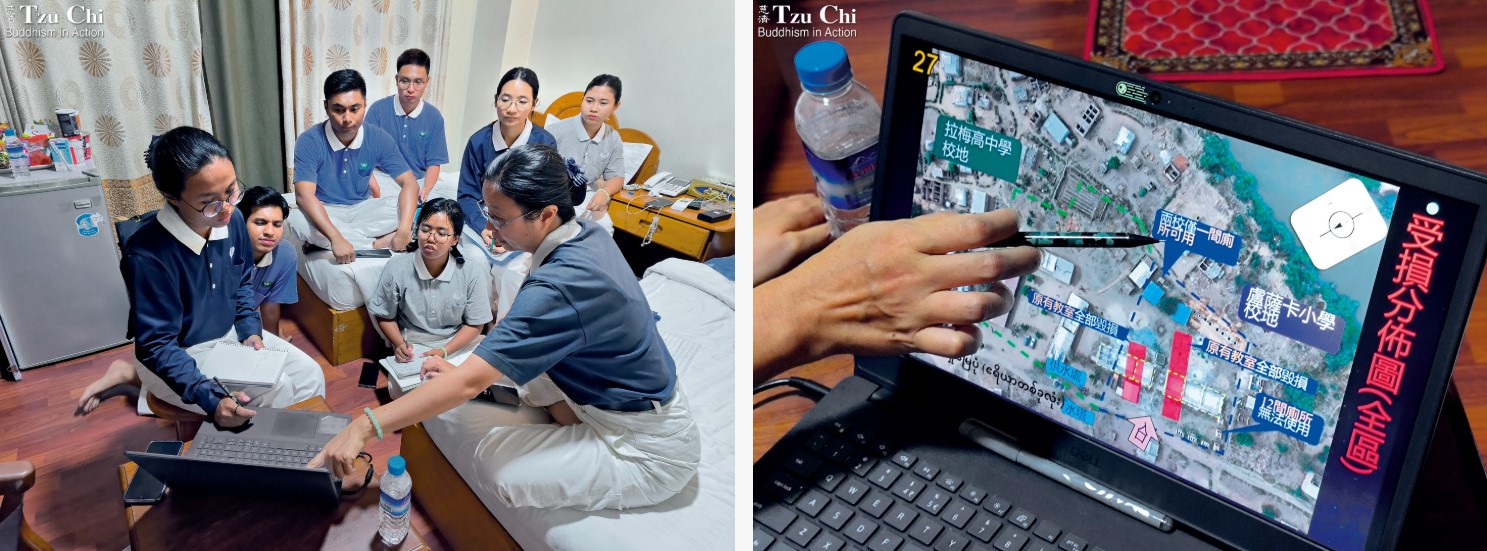
Volunteers returned to Mandalay on April 27 to begin the second phase of aid and data collection. Photo 1 shows Aye Nandar Aung (right) and other volunteers discussing the next day's schedule. (Phyo Pyae Aung)
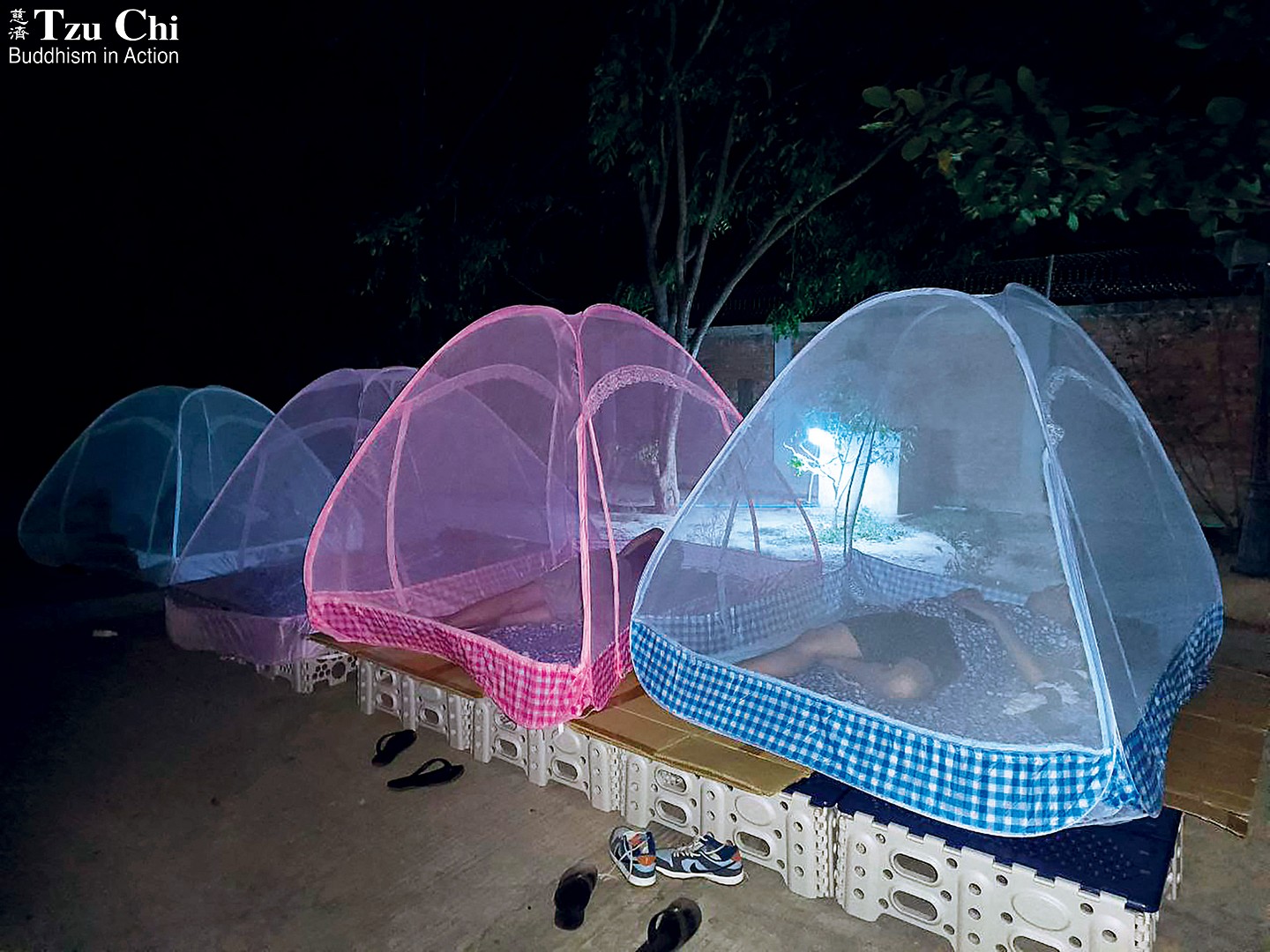
Another earthquake struck in the early hours of the volunteers' first day back in Mandalay in late April, causing many residents to rush outside. Here, the team takes shelter at a factory, spending the night on folding beds lined with cardboard and covered by mosquito nets. (Phyo Pyae Aung)
Prayers to soothe the pain
In addition to material aid, emotional healing was needed for those left traumatized by the earthquake.
"Our master is from Taiwan; she's very worried about everyone," said a Tzu Chi volunteer, referring to Dharma Master Cheng Yen. The volunteer and her team were visiting injured monastics in a hospital to offer comfort and convey the Master's concern. Many monastics had been hurt in the quake. One monk, who had lost his left arm in the disaster, saw an image of Master Cheng Yen on a volunteer's phone and, despite his pain, tried to stand and bow in respect.
At the time of the earthquake, more than a thousand monks were at U Hla Thein Monastery in Mandalay, sitting for a senior-level Buddhist examination. One of the monastery's buildings collapsed during the tremor, trapping about 200 monks. It was later estimated that 80 lives were lost. The monk who lost his arm had been serving as a chief examiner during the exam.
For many years, U Hla Maw—a 76-year-old longtime resident of the monastery—had helped prepare the exam site. He took pride in witnessing the emergence of a new generation of Dharma teachers each year. But this time, the memory of monks being carried out from the rubble remained vivid, filling him with deep sorrow.
It was against this backdrop that on April 17, the first day of the Burmese New Year, Tzu Chi volunteers and a local Dharma propagation association held a large-scale prayer and blessing ceremony at the monastery. A total of 550 monks from 34 monasteries participated.
Departing from tradition, in which monks typically face the congregation in such ceremonies, a senior monk suggested they instead face the building behind which most of the casualties had occurred. Facing this site, the monks then led the public in chanting and prayer.
During their time in the disaster zone, volunteers often heard residents say, "I keep hearing voices crying for help." In the hardest-hit areas, such cries had echoed for days after the quake, leaving a lingering sense of fear—one that may never have fully gone away, only pushed aside by the urgency to survive and rebuild.
The ceremony on April 17 held deep meaning for those attending. Community members prayed for lost loved ones, while monks offered chants for fellow practitioners and students who had passed away. Through this solemn Buddhist ritual, they honored the dead—and found a way to face their grief together.
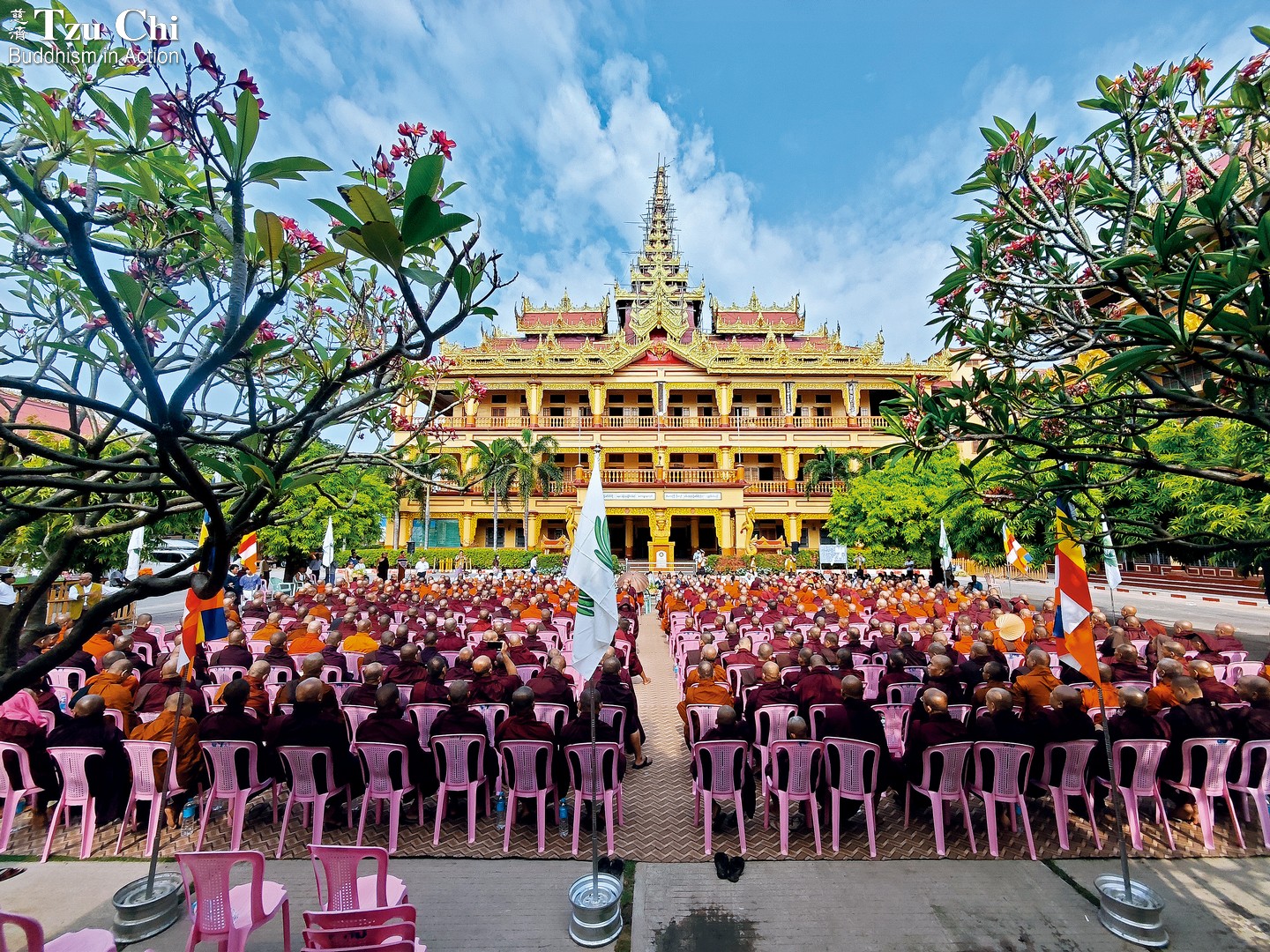
Monks and members of the public take part in a prayer ceremony at U Hla Thein Monastery on April 17, the first day of the Burmese New Year. Around 80 monks who had been sitting for a religious exam at the monastery on the day of the quake lost their lives due to the disaster. (Saw Tho Han Saw)
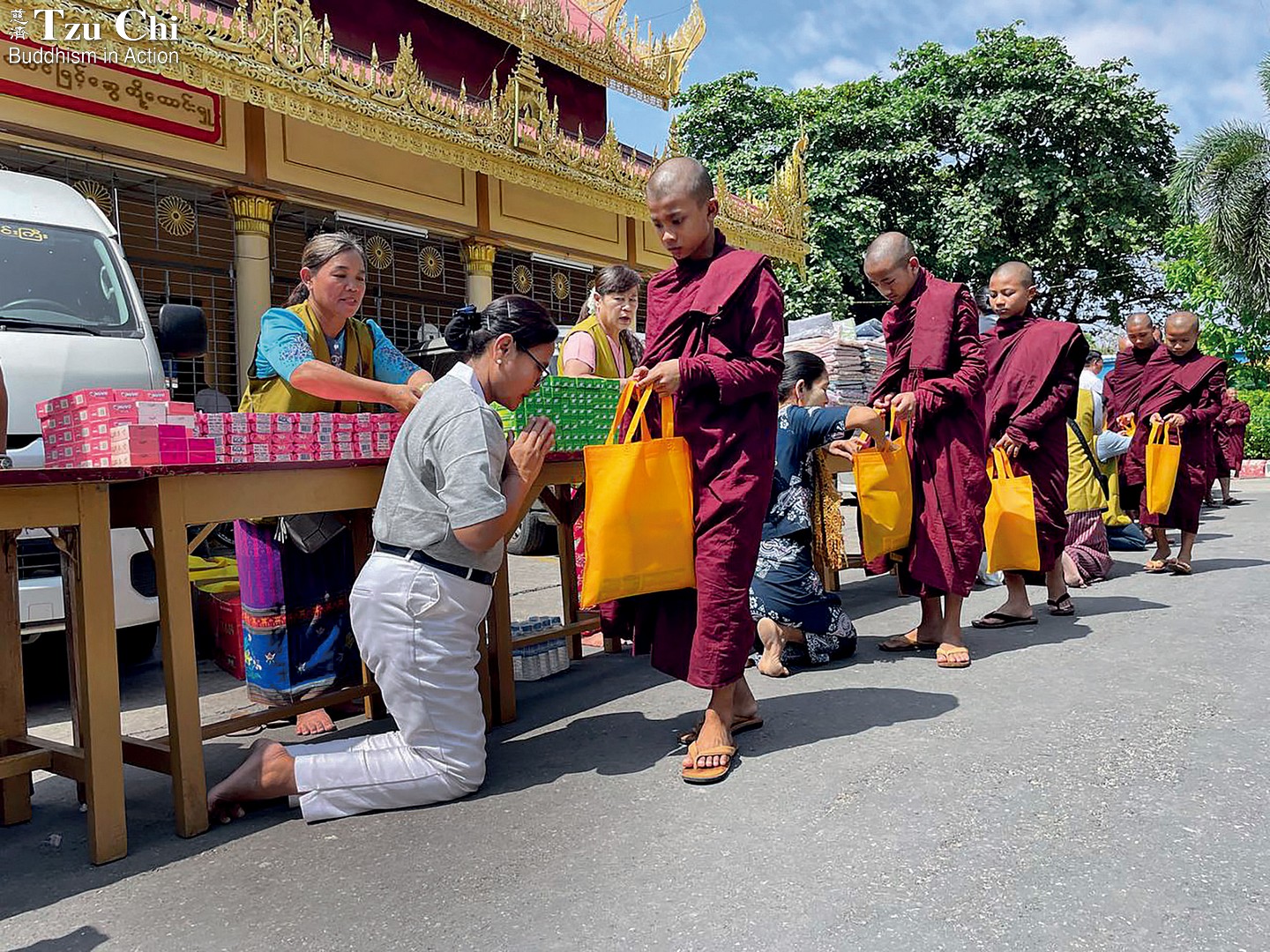
Volunteers respectfully place daily necessities for monastics at U Hla Thein Monastery into bags. (Wai Yan Htun)
Second phase
On April 27, Tzu Chi volunteers returned to the disaster area to carry out the second phase of relief efforts. This time, they conducted more detailed on-site assessments. They mapped the locations of damaged schools and monasteries and identified their specific needs.
In early May, a group of volunteers also traveled to Naypyidaw, Myanmar's capital, to meet with the Minister for Religious Affairs and Culture, U Tin Oo Lwin. Their goal was to gain a clearer understanding of the damage to pagodas or other religious sites and determine which areas were most in need of assistance. This would further inform the direction of Tzu Chi's ongoing support.
Between May 1 and 6, volunteers conducted 66 distribution events in the disaster area, delivering food, folding beds, and other supplies to monasteries, orphanages, and homes for the elderly. On May 6, the foundation held two free clinics—one at Nay Min Monastery and the other at Lay Kyun Man Aung Buddhist Teaching Monastery. Nay Min Monastery houses 300 students, many of whom were displaced by the civil conflict in the north. After the quake, they were forced to crowd onto a single floor, where the heat and cramped conditions led to widespread skin infections. Some of the young novice monks developed lesions that wouldn't heal due to constant scratching. In response, volunteers invited medical professionals to provide on-site treatment.
On May 8, a team of Malaysian volunteers arrived in Mandalay to prepare and begin construction of temporary classrooms for Mandalay Kongjiao School. Shortly after, starting on May 10, Tzu Chi launched another five-day rice distribution. The second phase of relief concluded on May 15, having brought not only practical aid but also comfort to communities still reeling from the disaster.
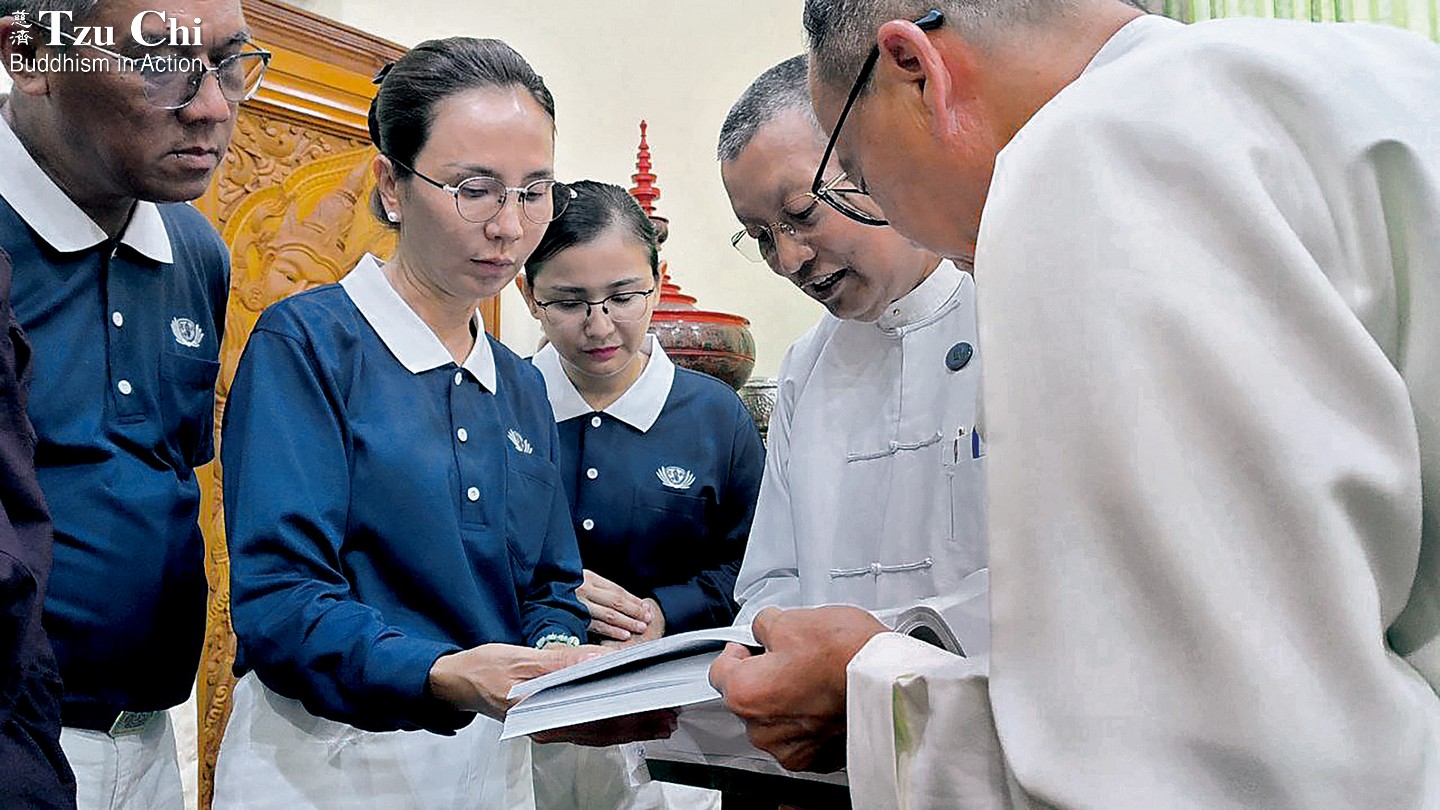
Daw Thida Khin (second from left) and other volunteers discuss assistance for the reconstruction of religious sites with Myanmar's Minister for Religious Affairs and Culture, U Tin Oo Lwin (second from right), on May 5. Many such structures were severely damaged in the earthquake. (Saw Tho Han Saw)
Every bit helps
"We've vowed to do our best to serve as the Master's eyes, hands, and feet," said volunteer Aye Nandar Aung, "and to carry out the love she wishes to give to everyone affected by the quake. To say we're not tired would be dishonest, but we find deep Dharma joy in this work. Volunteering with Tzu Chi isn't just about completing tasks—it's about cultivating a heart of loving-kindness, compassion, joy, and equanimity."
Whether speaking on camera or reporting at the Jing Si Abode, volunteers projected strength and optimism. But after witnessing so many broken families and irreplaceable cultural landmarks left in ruins, where could they place their sorrow?
"There was so much heartbreak," said Daw Thida Khin. "Some lost their children. In the face of such impermanence, how can we provide comfort and solace? We just hope they find even a little peace in what we offer." Perhaps this was where they placed it: by transforming sorrow into compassionate action.
According to the latest statistics, 200,000 people lost their homes in the earthquake. The road to recovery will be long. Of the ten member states of the Association of Southeast Asian Nations, commonly known as ASEAN, Myanmar ranks as the poorest, with average monthly incomes remaining low. Even the cost of demolishing a collapsed building can be overwhelming, making the challenges of reconstruction all the more daunting.
And yet, they are not alone.
Donations have come in from around the world. Patients receiving free eye care at the Tzu Chi Eye Center in Manila, the Philippines, have contributed, as have children at the Tzu Chi school in the Dominican Republic and Syrian students long supported by Tzu Chi in Türkiye. Even volunteers in Zambia—where nearly 60 percent of the population lives below the absolute poverty line—have given what they could. No matter where the money comes from, it carries love and compassion, everyone giving with the hope to help Myanmar recover.
Each contribution, no matter how small, adds strength to the path of recovery. In the face of profound loss, the combined efforts of local communities and compassionate supporters worldwide can better help a devastated region move forward.
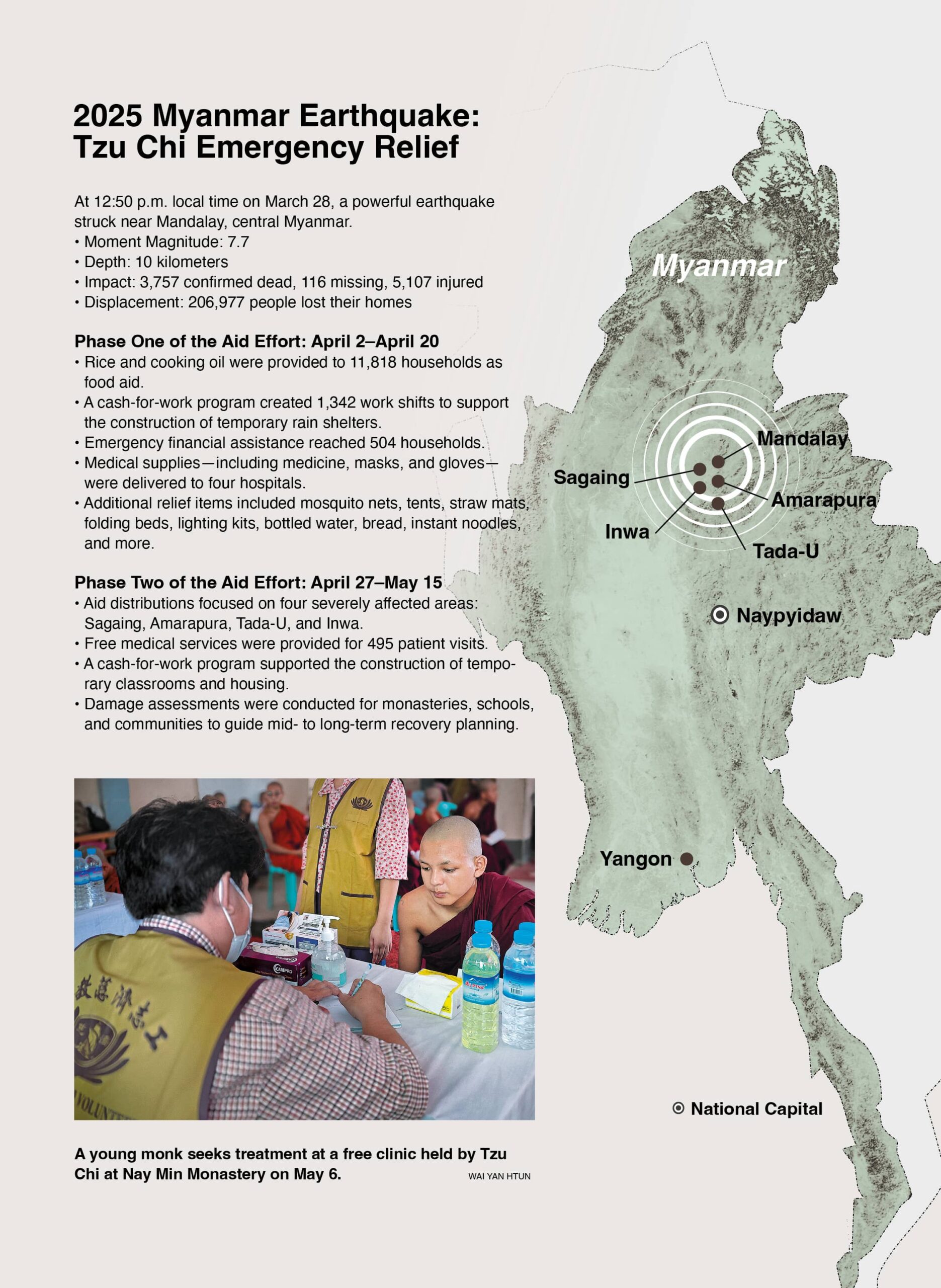
Contact Us | Plan a Visit | Donate
8 Lide Road, Beitou 11259, Taipei, Taiwan
886-2-2898-9999
005741@daaitv.com
©Tzu Chi Culture and Communication Foundation
All rights reserved.
